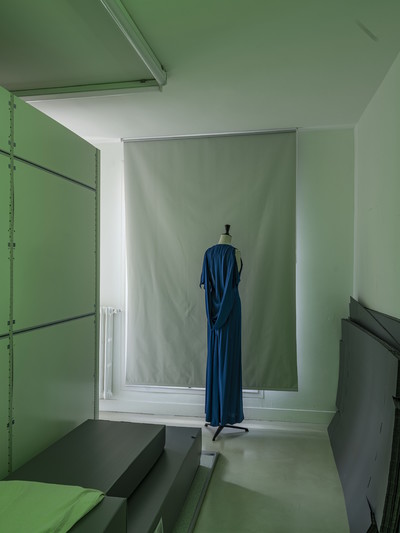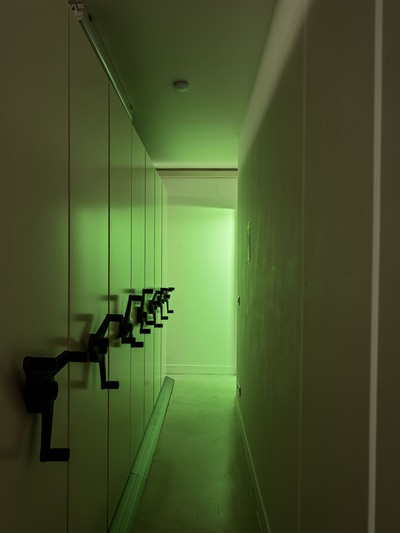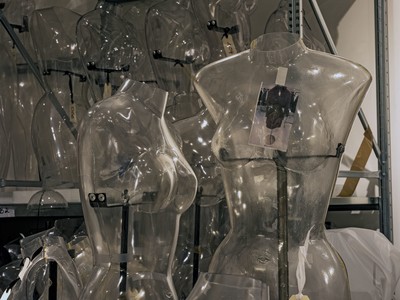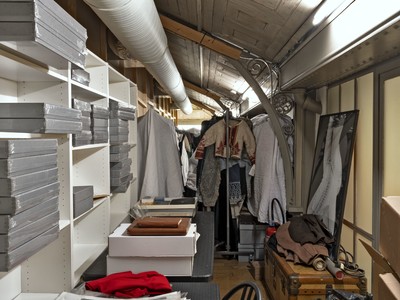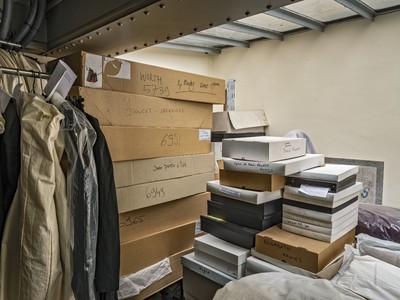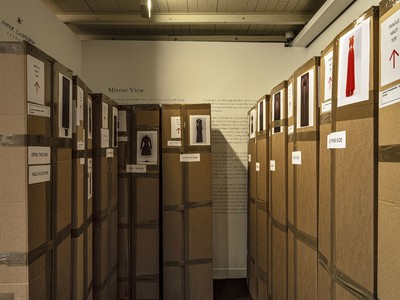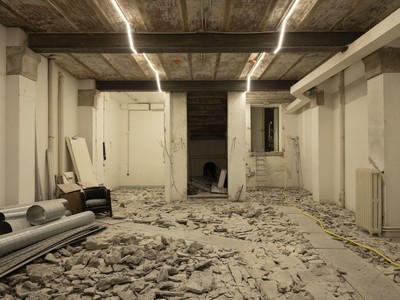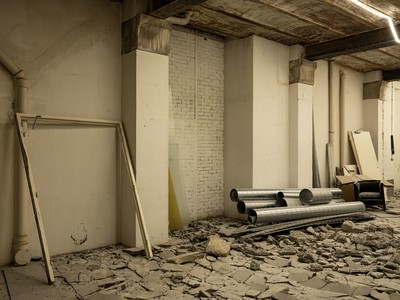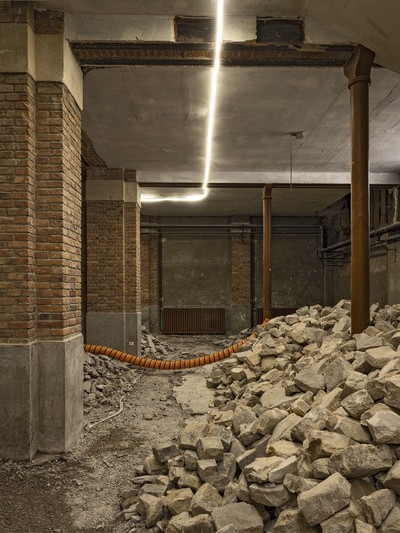Couture’s rebellious outsider spent his life amassing a 35,000-piece collection of fashion history, which no one had access to – until now.
Interview by Thomas Lenthal
Photographs by Robert Polidori
Couture’s rebellious outsider spent his life amassing a 35,000-piece collection of fashion history, which no one had access to – until now.
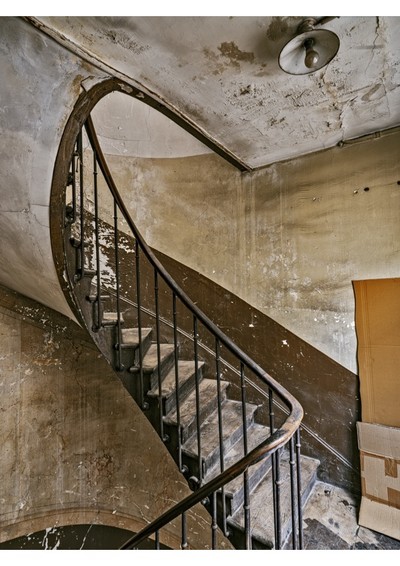
‘This building has always had a real soul, one that fascinated everyone,’ says Carla Sozzani, sitting in her office at 18 Rue de la Verrerie in Paris. ‘It’s a treasure that needs to be preserved, just like Azzedine’s work and the collections.’ From 1987 until the designer’s death in 2017, this exwarehouse in the Marais neighbourhood was Azzedine Alaïa’s home, HQ, studio, and gallery. Today, it is home to the Fondation Azzedine Alaïa, which has been guided, directed and inspired by Sozzani since its creation. ‘I first met Azzedine in 1981 and we became friends straight away,’ she says. With Christoph von Weyhe, Azzedine’s long-time partner, ‘we started working on creating the foundation in 2000 and began conserving everything – both his own work and the collection.’
That collection, which Alaïa began in 1968 and is today spread around the building from attic to cellar, is arguably the finest private fashion collection ever assembled: a remarkable selection of tens of thousands of pieces by designers both historical and contemporary, from Madeleine Vionnet, Balenciaga and Madame Grès to Courrèges, Comme des Garçons and Margiela. For Alaïa, its decades-long creation was both a quest to preserve fashion history and a powerful personal obsession. ‘He would go to auctions, but say he was going to the physiotherapist. I used to ask him, “How often do you need to see a physio?” And he never went to an auction with the same person, so no one would ever know how often he was going. There was one famous auction in 2005 where I did actually accompany him and he bought a Poiret coat. I could have killed him; it cost a fortune and we didn’t have the money. At one point, as the price reached €120,000 or so I said to him, “That’s not us bidding, is it?”’ Alaïa eventually paid €131,600 for the coat.
When the designer died aged 82, Sozzani knew she would need expert help to catalogue and archive the collection, which was bigger than anyone had ever imagined (‘He would buy things and not tell anyone,’ she says. ‘In his studio we found things he’d bought and then hidden’). So she turned to curator, designer and fashion historian Olivier Saillard, whom she says Alaïa ‘adored and respected’. In the following interview, Saillard discusses the details of Azzedine Alaïa’s remarkable collection, his sense of fashion history, and the future of this unique time capsule.
Thomas Lenthal: Do you know when Azzedine Alaïa started collecting clothes?
Olivier Saillard: We know exactly: it was 1968, when the house of Balenciaga closed and Mademoiselle Renée, who had been joint director of the house, called him and told him to come and collect the leftover dresses and fabrics, suggesting that he could do what he wanted with them, maybe use them for his own tailoring purposes. Azzedine would always recall, up until even a few months before his death, that he’d had an extraordinary revelation that day and his sense of fashion heritage had been born. He never stopped collecting clothes from that moment onwards.
What was his goal when he started the collection?
He’s an extremely rare case: the only man in fashion who ever really cared about its history, not just his own, but that of the entire discipline. In design, and traditional and contemporary art, you see artists who become collectors, but in fashion, there is only one: Alaïa. This little designer originally from Tunis, who immoderately collected objects related to the history of fashion created by its great names. I think he was scared of being forgotten, as happened to other couturiers. I remember he was marked by the sad end of Paul Poiret, and the tragic end of Jacques Fath, and how these once big names had been forgotten. He would call me when I was director of the Musée Galliera and tell me he was outraged and upset that we weren’t collecting or buying more clothes for the museum. He saw them as physical proof of many hours of work because, as a man of the atelier, he knew just how long it took to make even the simplest garment, and the lifetime’s commitment that each represented. He couldn’t bear the idea that the memory of this atelier work and that of the couturier might be discarded.
Was it always his ambition to build an important collection?
It became so almost in spite of Azzedine himself. Two collections marked his life as a fashion historian: those of the Musée des Art Décoratifs and UFAC. One day Yvonne Deslandres, who ran the place, asked him to come and help her put the Madeleine Vionnet dresses on mannequins, because she couldn’t work out which way round they went. We know that clients did sometimes go back to the house to be helped in putting their dresses on, because they didn’t understand how. Azzedine loved that about Vionnet – you have to know the inside of the garment and the technique behind it. It was like he was always trying to reassure himself about his technical skills when compared to other designers. He learned from them, but he never copied. I’ve never found any clothes that he took apart, so my theory is that he learned by studying how, say, a sleeve was put together. A curator who analyses just the style or the work can’t possibly know that about a garment. That experience made him aware of the role that he could have in history, and consolidated and increased his desire to collect. It was like a mission, but he didn’t seem to want to show it – it was the act of collecting that was more important.
Do you think his position evolved over time?
It evolved according to the amount he was able to invest in it. Yet even when the house was at its most fragile and vulnerable, Azzedine was still at auction houses buying pieces at insane prices. In the 1980s, the designer Adrian died. He had been MGM’s main costume designer and also had his own house. His son called Azzedine and said, ‘I have all my father’s archives, all his sketches, and it’s all an hour from New York.’ Azzedine was in the city at the time and so went over there in a lorry and bought all of it. Every piece. He had this desire to compete with the fashion museums, with whom he’d both clashed and fallen in love. He wanted to collect pieces himself, those the museums didn’t always have the means to buy.
How many pieces are there in the collection?
There are more or less 15,000 pieces in the historical Patrimoine collection, and then on top of that, there is also the collection of all the clothes that he designed, which is about 20,000 pieces.
So, 35,000 pieces in total. Who are the designers and roughly how many pieces are there per designer? I’ve heard that he edited the history of 20th century fashion by choosing a certain amount for each designer…
He had all the master couturiers, the veritable architects. He clearly wanted to be part of a sort of family tree that begins with Vionnet, Balenciaga and Madame Grès. There is a lot of Madame Grès and we’re still finding new ones, but we’re already at around 600 pieces for her. Some Schiaparelli. His taste for Poiret developed a little more when he hosted a sale of a collection owned by the Poiret family in 2005, and then he bought a lot. In order: Balenciaga, 600 to 700 pieces; Grès, more than 600; Vionnet, a bit less. Adrian, it’s the biggest collection in the world; no museum in America has more. There is a fair amount of Dior because Azzedine used to say that having grown up in Tunisia, Dior evoked France and Paris. He was always curious to know how the underside of Dior dresses were constructed. Lots of early Chanel, from Mademoiselle Chanel’s time, and lots of suits and early pieces. Quite a bit of Lanvin, Poiret and a lot of Jacques Fath. And then there are all those couturiers whose reputations have faded, because the houses weren’t bought – secondary names, like Augusta Bernard who was the height of chic, pure simplicity. For me, her work is even more beautiful than Vionnet, but she’s virtually forgotten. And lots of Jean Patou dresses – a key person who has also been forgotten today, some beautiful looks. And so many more others, Claire McCardell, Charles James… But not in quite such vast quantities as the others.
‘The collection includes 600 to 700 Balenciaga pieces; more than 600 Grès; Vionnet, a bit less. Adrian, it’s the biggest collection in the world…’
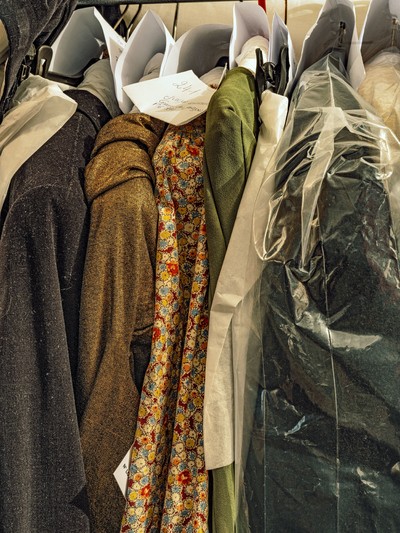
And among his contemporaries?
It’s large. There is Cardin and Courrèges, including 40 pairs of shoes! Then from later, a lot of Comme des Garçons, Yohji Yamamoto, Issey Miyake, lots of Junya Watanabe, and Japanese designers in general; Margiela, Jean Paul Gaultier, Thierry Mugler, with whom he actually worked and who really helped him at the beginning. And Westwood who would come to the shows here; Galliano. Some Saint Laurent, because Azzedine sewed the Mondrian dresses, so one day he bought the dress that he himself had made. He would often go and help out houses when they were missing staff and when they needed a beautiful hand.
It’s a big collection for an individual collector, but is it comparable to a museum collection like the Costume Institute at the Met in New York?
In terms of size, no, the Costume Institute at the Met is more important. That’s the biggest. There’s one really big difference, though: museum collections, whether it’s the Met, Musée des Arts Déco or Galliera, are built on and rely on donations. So they have weaknesses because they might accept one beautiful dress, but have to accept four more that aren’t so interesting. Azzedine’s collection might be a bit smaller, but it has a vast number of amazing pieces, because they were all chosen by him. He was the curator from start to finish. From 1968 onwards, he was the only person to choose, buy, research and build the collection – which means not much is worthless. Certain parts of the collection are actually better than the museums – you could never organize a Jean Patou exhibition only with museum collections, but with Azzedine’s, you really could.
Did he ever talk about a moment when the collection would be completed or did he just continue to buy without any real notion of completion?
It was never completed because he kept buying all the time. He was insatiable. It was mysterious: when you’d ask him what he was going to do with the collection, he would stay silent. He didn’t want to show it, although he’d occasionally say, ‘We’ve established an association to preserve this collection in the hope of it becoming a foundation.’ It was very intimate, but I think he was saying, ‘I created this collection, but it will be for others to order, develop and show it.’
We can trace the history of fashion and couture through his collection. Did he go and see other fashion collections in museums?
He would see other collections and visit exhibitions alone. He saw every single designer exhibition with a certain generosity, a sort of indulgence, which was not always his style. He was also sought after by curators happy to have a designer with whom they could talk about the history of fashion, someone who could discuss it with genuine taste, and bring a highly specialized technical analysis. They used to have to fight him off at the sales; he was a really educated character in that aspect. It’s extremely rare that a couturier is so well informed about the history of fashion.
Was he interested in the provenance of the pieces?
Very much so. He was interested in the clients; he loved the cult of the big famous client. He would buy Balenciaga dresses that had been owned by Elizabeth Taylor, or things that had belonged to Garbo and Claudette Colbert. He once bought the entire wardrobe of a famous model from Jean Patou from the 1930s, the most beautiful pieces.
‘Azzedine’s an extremely rare case: the only man in fashion who ever really cared about its history, not just his own, but that of the entire discipline.’
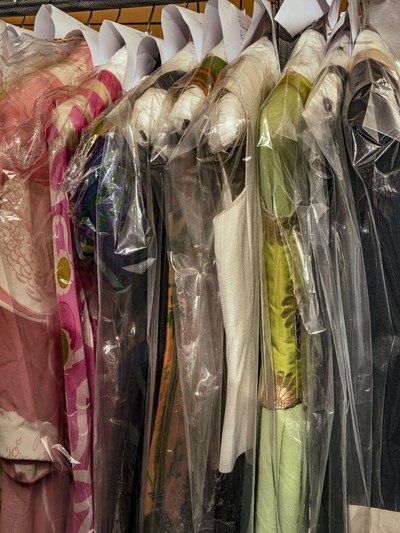
Before you started, did you know of what exactly the collection consisted?
I knew there was a lot because he’d been buying for nearly 50 years, but I had no idea quite how much. I had no idea that the five floors were full of boxes, and that all the apartments that he had bought and were still in their original state, last decorated in the 1970s, 1980s, were filled. The entire basement was also full of boxes.
And you’d never seen any of it?
No, no one had. Only two people who worked at the house were allowed in: Rachid, who helped fold them and Sarah, who has been here forever and helped him wrap the garments. The clothes were pretty well preserved. Not exactly like in a museum, but a garment that’s been laid flat and protected from the light can last a long time. The collection was vast, and no one had access to it. When he died, it was a bit overwhelming to find myself with the privilege of seeing it. I also felt slightly guilty as it was only after his death that we really discovered it. I would have liked him to be there when I saw it. I’m not sure he wanted to see what he had acquired, though; he preferred to just keep building it.
When you opened the boxes, was it all mixed up?
All mixed up – you would have some Jean Patou with Vionnet and then some Westwood. It was pretty incoherent, but generally carefully stored.
Is the inventory now complete?
No, no, but it’s advancing well. On the historical side, we have two people working with me on the inventory, who work on the computer with photographs. The exhibitions we’ve done on Adrian and Balenciaga have also really helped us progress. We’ve done building work on all the floors to convert the rooms and put up mobile aisle shelving, like you find in museums. We have bought proper clothes covers; we’ve removed all the dust. On the historical side, I would say that 95% of the work is done, but an inventory never really finishes. You have a dress that you’ve described briefly to start with, but then you have to document it in more detail later. We’re getting there, though.
So I’m guessing that you now know what Azzedine considered to be the height of the art of couture?
There was no question about it: it had to be Balenciaga, his expertise in both tailleur and flou. Indeed, Azzedine was the only one to have really re-explored flou dresses after 2000, and they are very, very pretty. At one point, Azzedine tried to go beyond technical demonstrations, and as he got older, he moved towards effortless simplicity. That work really does compete with Balenciaga who I think he saw as the real couturier and someone from whom he learned. Azzedine would have put him first, even if Vionnet was a sort of fashion ideal.
Because Vionnet is the most complex, the most complete in terms of patterns?
In early Vionnet, it is complex and sometimes it is a bit too sophisticated in terms of technique. Sometimes a technique is good because it’s simple. Grès is much less sophisticated and technical, but remains exemplary. With Vionnet, what he admired was her intransigence, how she ploughed her own solitary path, and her research. She decided to do only what she knew how to do; in other words, she never succumbed to fashion’s passing fads, and instead retained a strict sense of design that came to an end at a certain point. She also did so much to combat copying and Azzedine was always furious with copiers; he didn’t understand how you could be a designer and pillage the work of others. And Vionnet did a great deal for the artistic recognition of couturiers, setting legal precedents by taking legal action. In 1929, Vogue has a story about an important case she took against plagiarizers and counterfeiters, which she won and ensured that fashion designers and their creative work had the same legal recognition as other arts.
How did you become involved with the foundation?
I first met Azzedine in 1995. He was president of the Espace Mode Méditerranée in Marseille and I had just been appointed as curator of the city’s Fashion Museum. He already had a really active role in advising on the fashion purchases for the museum. Then that ended because I think he really wanted to continue collecting for himself. Then we lost contact, but in 2013, I suggested that he should be the subject of the exhibition with which we reopened the Musée Galliera after its long closure. He was so honoured by the fact that he was being recognized by the museum. During the show he would visit every two days, taking people round, both celebrities and others. He was really very proud of the exhibition. He died in 2017, so if we hadn’t done that exhibition, he wouldn’t ever have had a retrospective in a French museum during his lifetime. He was always very flattered to be considered not just as a couturier, but as an auteur, an artist. After that, we established a great relationship. When he died, we were all extremely shocked; it really came out of nowhere. He didn’t ever want to talk about age. After he died, I had a drink with Carla one evening, and she asked if I’d like to come and help with the foundation, and that Azzedine would have been happy for me to become the director
and start the inventory. I really didn’t want to do any more archives, but it felt like a mission. Azzedine had not just collected clothing; he had also saved a part of French history and a fashion legacy like no museum would ever have been able to do. It felt unimaginable that all of this could disappear, not to mention Azzedine’s own work, which I place high in the hierarchy of designers and couturiers. So I worked for free for two years and we got it on track. I had one thought in mind and I told Carla: I would do this so that one day the foundation has the means to become a museum. Create the archives, the inventory – basically, duplicate everything I have done in the museums here at the foundation, and get people from museums involved. The foundation’s projects are to finish the archiving of all Azzedine’s collections, including the historical Patrimoine collection, in adapted storage facilities like in a museum. Another mission is to organize exhibitions: one a year that talks about the work of Azzedine, and then another that uses the historical Patrimoine collection and his work together. With Carla, we’re very careful not to give away everything at once, so as not to exhaust the subject. For example, if we do an Adrian and Azzedine show, we would focus on suits, which would mean excluding all the dresses. After the death of a couturier, people immediately express admiration, but then turn off, so you don’t want to reveal everything all at once. Then there’s how the work is seen. We’re working on a Peter Lindbergh and Alaïa exhibition, which is a wonderful way to reveal his oeuvre through photographs, his taste for the cinema and the design collections. One rare time Azzedine talked to me about the project – and Carla had already understood this – he said that this building is like the Palazzo Fortuny in Venice. It’s a place for work, living, exhibiting; there is everything here, a space for a runway show, the ateliers. It’s a unique space in the heart of Paris – it’s a real maison and it has Azzedine’s apartment and studio, which are marvellous. When he died, Carla laid dust sheets over everything and it has stayed exactly as it was. All we need to do is open the doors and it can be visited immediately. The boutique will eventually become a museum space; that’s in the foundation’s charter. Azzedine prepared his afterlife rather well; none of this was destined to be forgotten. When you have all these people
in their white jackets preparing an exhibition, there is life here; it’s like when you have lots of people in a kitchen. It really feels like what Azzedine would have wanted. There are also education projects, for handing down knowledge to future generations. Our vocation is to use Alaïa to talk about techniques, not style; that’s for others – we are all about technique. It’s a challenge because it is more difficult to explain technique – ‘this is how you cut a jacket’ – but I think it has a magic that belongs to Azzedine. We’re not about rewarding a student from, say, Saint Martins, but rather one from a vocational high school in Lyon who happens to be an amazing pattern cutter. We are looking to help people from disadvantaged backgrounds. That mission is presided over by Farida Khelfa.
‘Even when Azzedine’s own house was at its most fragile and vulnerable, he was still going to auctions and buying historical pieces at insane prices.’
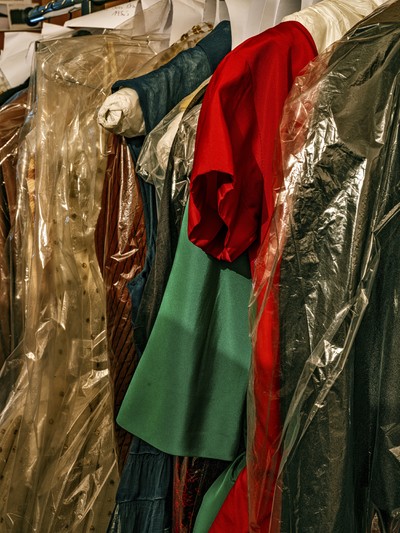
What do Azzedine’s choices and his vision of contemporary fashion say about the industry?
His choice of contemporary designers includes those with an ‘auteur’ value, whether it is Margiela, Nicolas Ghesquière or earlier, Yohji, Comme des Garçons. He was an expert in the value of the auteur and that was what interested him more than anything, especially the Japanese. He used to invite both Yohji and occasionally Rai Kawakubo for dinner at his house. If you look at archive footage of fashion shows, often the only other designer present was Azzedine; he would be there in the front row. There was this sort of understanding and mutual admiration between them. There was this sort of appreciation of differences in style; he loved people’s work that was very different to his. His fashion collection is so informed and so educated. It really does reflect the history of fashion.
Did he talk about his collection to these other designers?
He didn’t show it to them, but he talked to them. He was very proud of it. I think he would talk to people who were open to it; I think he talked about it a lot with Nicolas. I remember after McQueen committed suicide, he was downhearted about it and he talked about how the fashion system was responsible for his death. There were signs in the fashion system that he didn’t like. He really understood certain people who refused the system and needed to be independent, like he was. That independence often cost him dearly. If you look at him purely from a historian’s perspective, he spent 20 years as a completely unknown couturier, then there was the first ever show in 1979, and then the glory years in the 1980s. But by 1995, he was almost completely forgotten about by the press, even if he did everything for that to happen; he was very cross with a lot of people. Azzedine was never a young man in the spotlight; at the height of his fame, he was already an older man. He started his house after 30 years in the business. He did everything with a certain slowness. Between 1995 and 2000, when the big groups started financing things and Prada bought the house, he was actually ready to shut up shop altogether. Meanwhile, he was buying Poiret dresses at auctions. Then all of a sudden, things fell back into place and he pulled himself together: couturiers rarely become so good again at the end of their careers.
No artists or couturiers – no one really.
I do like Chanel’s comeback, even though it wasn’t her best. It was so daring to make a return like that in 1954 and to start schooling everyone. Azzedine wasn’t like that, but he became the great technician. At a time when people were being fired from the houses by the luxury groups, when it was all about style, and just as a new generation was arriving, Azzedine was making the most beautiful white shirts, the most beautiful and most sophisticated evening gowns. Two collections I adore are 2003 and 2011 – they were really incredibly beautiful and without any artifice or mise-en-scène. There are some clothes that from afar, you don’t see their complexity, and I think that is interesting. Azzedine is cutting in volume. It isn’t couture; it’s knowing how to cut, and he was so good at that, above and beyond everyone else. There were highs and lows with Azzedine, and we haven’t even talked about his moods. Sometimes he would be suicidal, destructive; I think it was a subconscious need to destroy, occasionally.
Paradoxically, you get the impression that he was also incredibly disciplined and industrious…
Right up to his death, he was in his studio every day and he never went anywhere in the summer. If he travelled, it was to see an exhibition about his work or for a reason; he didn’t like tourism or leisure. He was a studio man, like Merce Cunningham, cut from the same cloth. Even with his deformed hands, he was still sewing. He was pugnacious. The maison here is like a medina, a city within a city. Everything is here, and that was his great luxury – not having to go anywhere and instead receiving the entire world here. That is what he did with his kitchen, around which so many people have built this myth. It was here that everyone got together and mixed.
And finally, there is a fascination for the feminine with Azzedine; it’s quite specific to him.
It’s the only case that I have studied. There is always a fascination for the feminine with couturiers, but it’s a fantasy about femininity, which is in some ways the couturier seeing himself wearing those clothes; there is a sort of projection. The only one who never really projected himself like that was Azzedine.
Do you see this dialogue between his collection and this fundamental aspect of his oeuvre when you see the pieces?
There was a genuine love of women, that’s for sure. They fascinated him; he often talked about his fascination with Greta Garbo, Oum Khalsoum, and with other great women. He was definitely more fascinated by women than by men, for sure. There was a sort of great admiration for women with great spirit, liberated women, whether unknown or famous, those with an independent femininity. Azzedine felt that what made women beautiful was a sort of authority, a mastery of elegance or style. His grandmother was very autonomous, his mother left his father, and neither ever remarried. There were women in his life who were very influential, incredibly autonomous for their generation and their country and their social position. You know how Azzedine learned he was good at sewing? By doing his sister’s sewing homework in the evenings, and he was really motivated when she got great marks. He then worked as a seamstress to fund his studies. Yet it’s always more about the technical exercise and the memory of the oeuvre than just femininity. Dior and Jacques Fath, for example, made very feminine things, but they could come close to sentimentality. Azzedine’s really not like that. With him, it’s more about architecture and volume – and that was also what he collected.
•
‘There’s a film that we found from 1990,’ concludes Carla Sozzani, ‘when Azzedine had just bought the building. He is giving a journalist a tour and says that he has 4,000 square metres of space and that the whole thing will be completely filled. And look now – it’s magnificent. We’re going to have the most beautiful museum, which was what he wanted: he wanted to leave his mark.’
